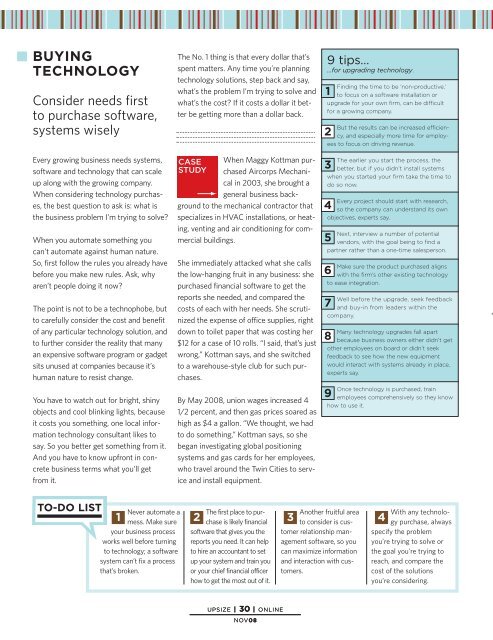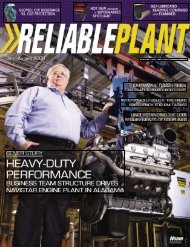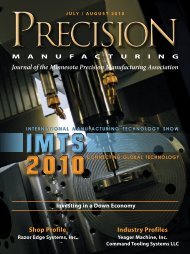upsize online resource directory
upsize online resource directory
upsize online resource directory
Create successful ePaper yourself
Turn your PDF publications into a flip-book with our unique Google optimized e-Paper software.
BUYING<br />
TECHNOLOGY<br />
Consider needs first<br />
to purchase software,<br />
systems wisely<br />
Every growing business needs systems,<br />
software and technology that can scale<br />
up along with the growing company.<br />
When considering technology purchases,<br />
the best question to ask is: what is<br />
the business problem I’m trying to solve?<br />
When you automate something you<br />
can’t automate against human nature.<br />
So, first follow the rules you already have<br />
before you make new rules. Ask, why<br />
aren’t people doing it now?<br />
The point is not to be a technophobe, but<br />
to carefully consider the cost and benefit<br />
of any particular technology solution, and<br />
to further consider the reality that many<br />
an expensive software program or gadget<br />
sits unused at companies because it’s<br />
human nature to resist change.<br />
You have to watch out for bright, shiny<br />
objects and cool blinking lights, because<br />
it costs you something, one local information<br />
technology consultant likes to<br />
say. So you better get something from it.<br />
And you have to know upfront in concrete<br />
business terms what you’ll get<br />
from it.<br />
The No. 1 thing is that every dollar that’s<br />
spent matters. Any time you’re planning<br />
technology solutions, step back and say,<br />
what’s the problem I’m trying to solve and<br />
what’s the cost? If it costs a dollar it better<br />
be getting more than a dollar back.<br />
CASE<br />
STUDY<br />
When Maggy Kottman purchased<br />
Aircorps Mechanical<br />
in 2003, she brought a<br />
general business background<br />
to the mechanical contractor that<br />
specializes in HVAC installations, or heating,<br />
venting and air conditioning for commercial<br />
buildings.<br />
She immediately attacked what she calls<br />
the low-hanging fruit in any business: she<br />
purchased financial software to get the<br />
reports she needed, and compared the<br />
costs of each with her needs. She scrutinized<br />
the expense of office supplies, right<br />
down to toilet paper that was costing her<br />
$12 for a case of 10 rolls. “I said, that’s just<br />
wrong,” Kottman says, and she switched<br />
to a warehouse-style club for such purchases.<br />
By May 2008, union wages increased 4<br />
1/2 percent, and then gas prices soared as<br />
high as $4 a gallon. “We thought, we had<br />
to do something,” Kottman says, so she<br />
began investigating global positioning<br />
systems and gas cards for her employees,<br />
who travel around the Twin Cities to service<br />
and install equipment.<br />
9 tips…<br />
…for upgrading technology.<br />
1<br />
Finding the time to be ‘non-productive,’<br />
to focus on a software installation or<br />
upgrade for your own firm, can be difficult<br />
for a growing company.<br />
2<br />
But the results can be increased efficiency,<br />
and especially more time for employees<br />
to focus on driving revenue.<br />
3<br />
The earlier you start the process, the<br />
better, but if you didn’t install systems<br />
when you started your firm take the time to<br />
do so now.<br />
4<br />
Every project should start with research,<br />
so the company can understand its own<br />
objectives, experts say.<br />
5<br />
Next, interview a number of potential<br />
vendors, with the goal being to find a<br />
partner rather than a one-time salesperson.<br />
6<br />
Make sure the product purchased aligns<br />
with the firm’s other existing technology<br />
to ease integration.<br />
7<br />
Well before the upgrade, seek feedback<br />
and buy-in from leaders within the<br />
company.<br />
8<br />
Many technology upgrades fall apart<br />
because business owners either didn’t get<br />
other employees on board or didn’t seek<br />
feedback to see how the new equipment<br />
would interact with systems already in place,<br />
experts say.<br />
9<br />
Once technology is purchased, train<br />
employees comprehensively so they know<br />
how to use it.<br />
TO-DO LIST<br />
Never automate a<br />
mess. Make sure<br />
your business process<br />
works well before turning<br />
to technology; a software<br />
system can’t fix a process<br />
that’s broken.<br />
The first place to purchase<br />
is likely financial<br />
software that gives you the<br />
reports you need. It can help<br />
to hire an accountant to set<br />
up your system and train you<br />
or your chief financial officer<br />
how to get the most out of it.<br />
Another fruitful area<br />
to consider is customer<br />
relationship management<br />
software, so you<br />
can maximize information<br />
and interaction with customers.<br />
1 2 3 4<br />
With any technology<br />
purchase, always<br />
specify the problem<br />
you’re trying to solve or<br />
the goal you’re trying to<br />
reach, and compare the<br />
cost of the solutions<br />
you’re considering.<br />
UPSIZE | 30 | ONLINE<br />
NOV08
















